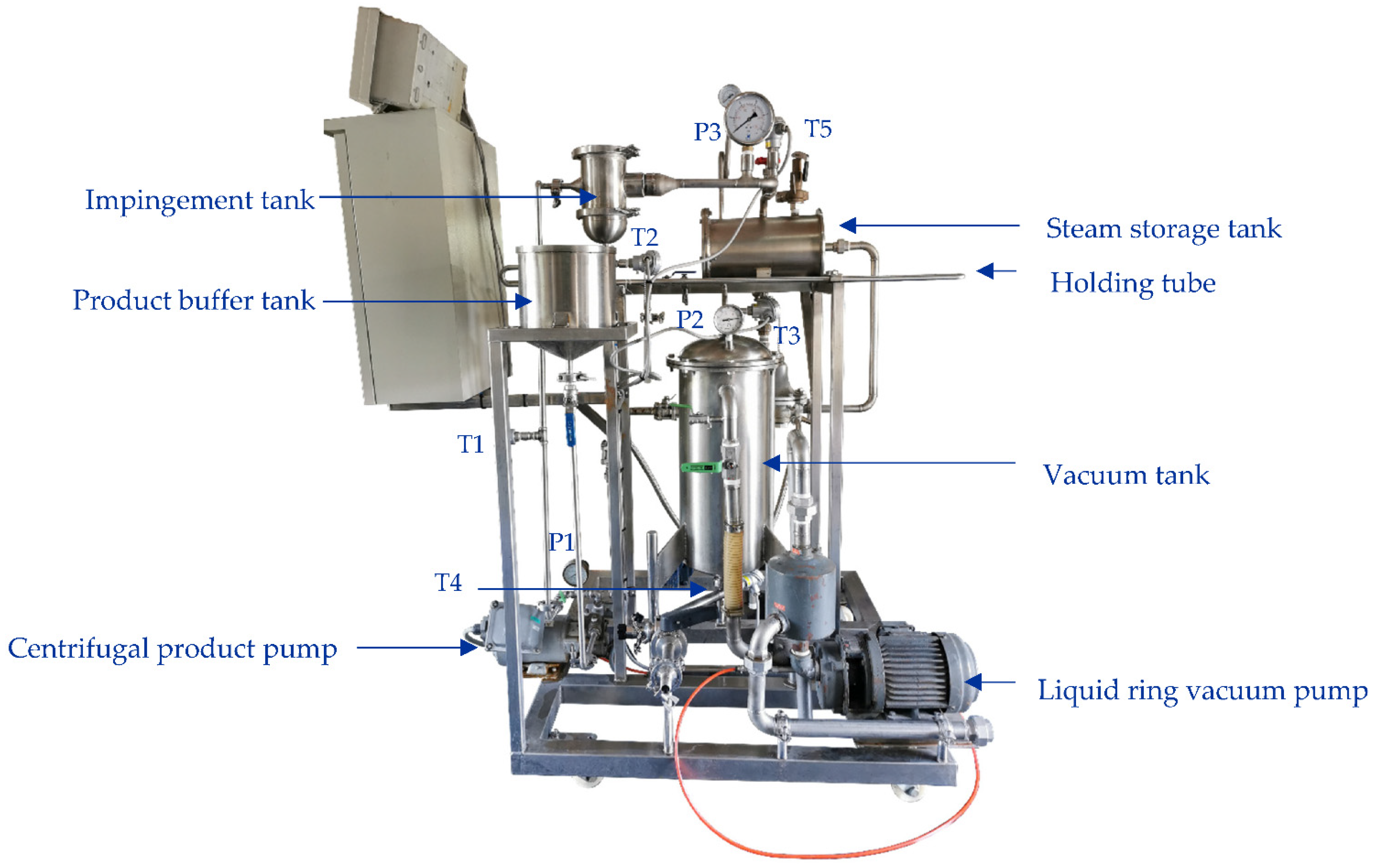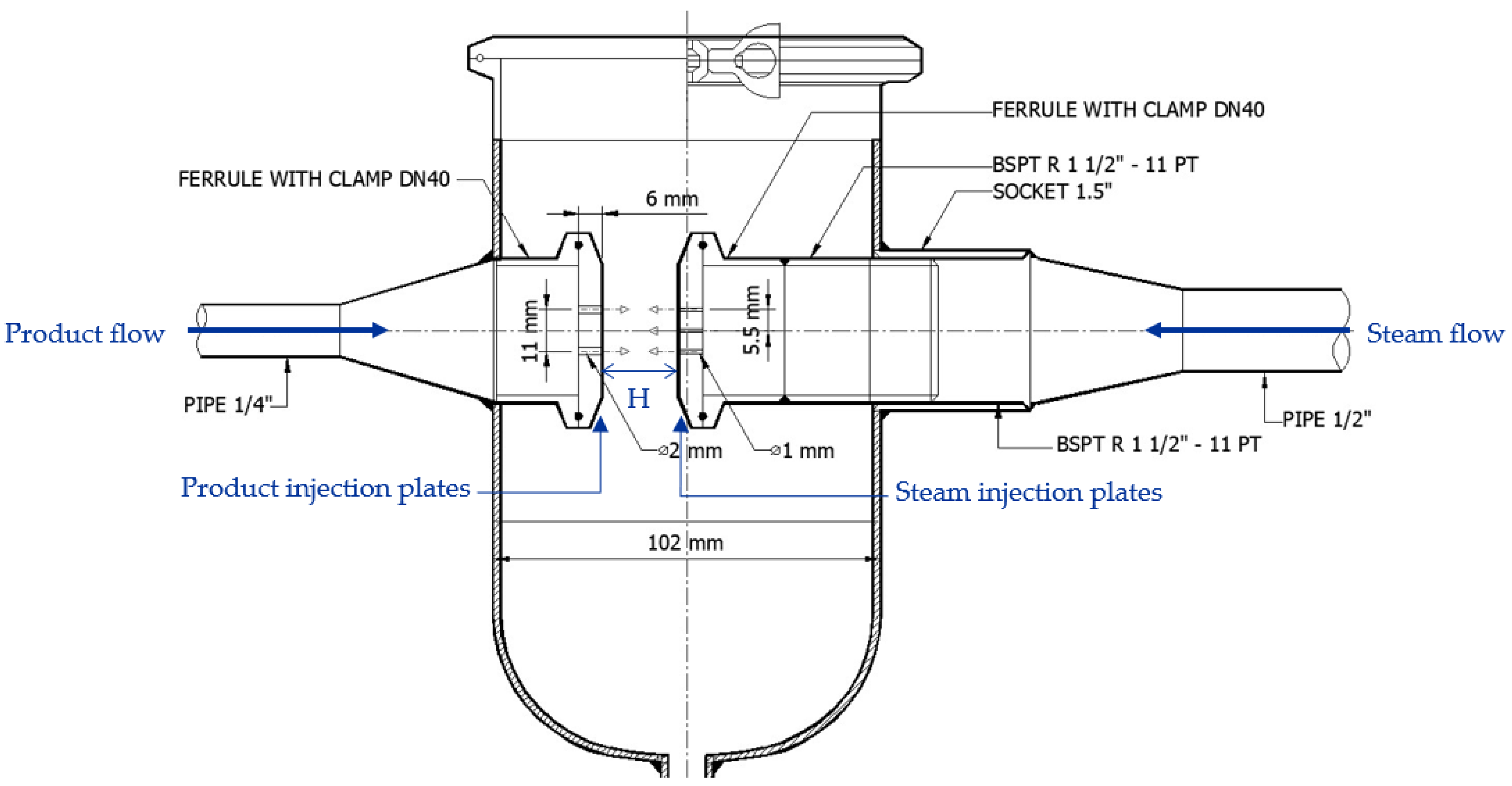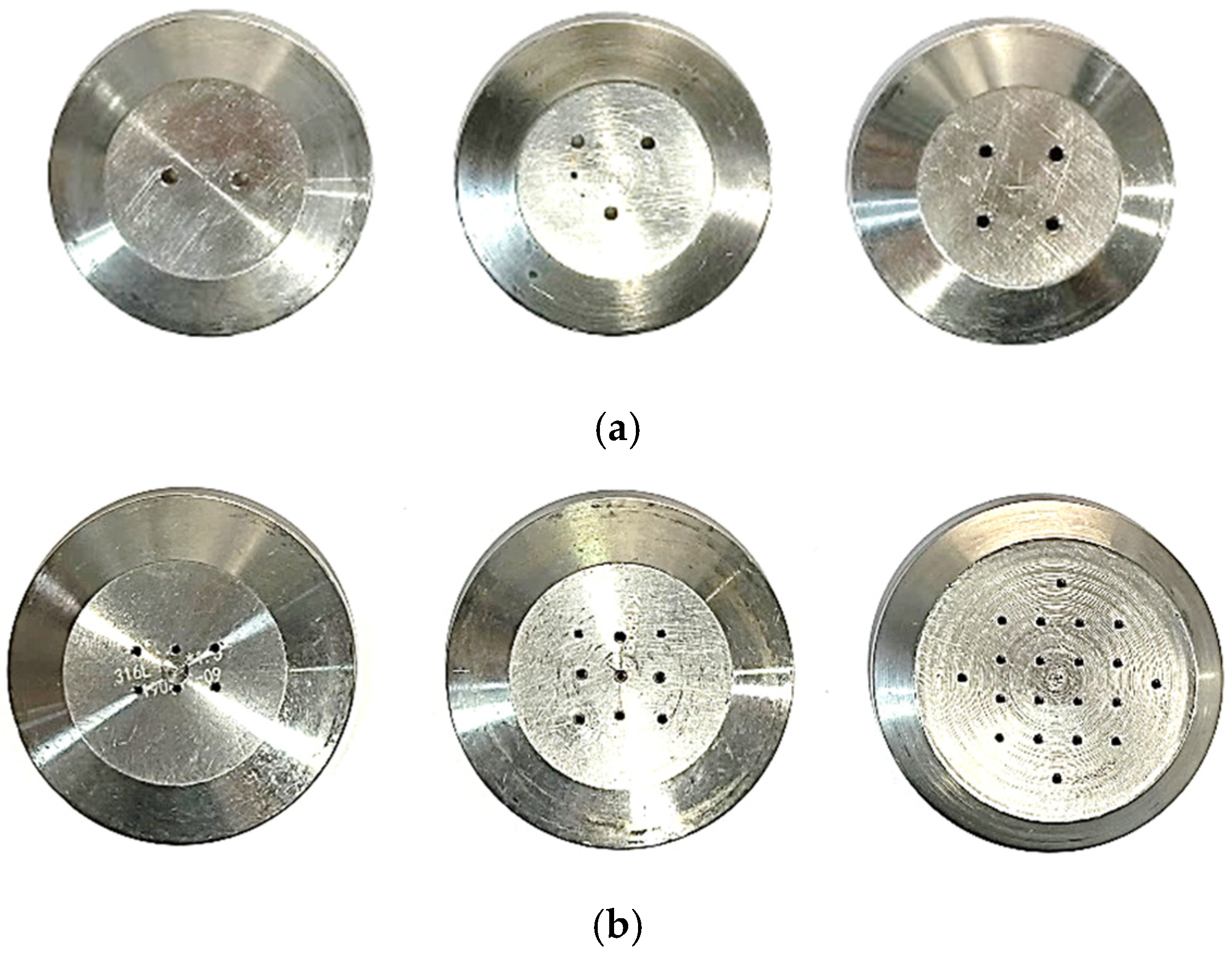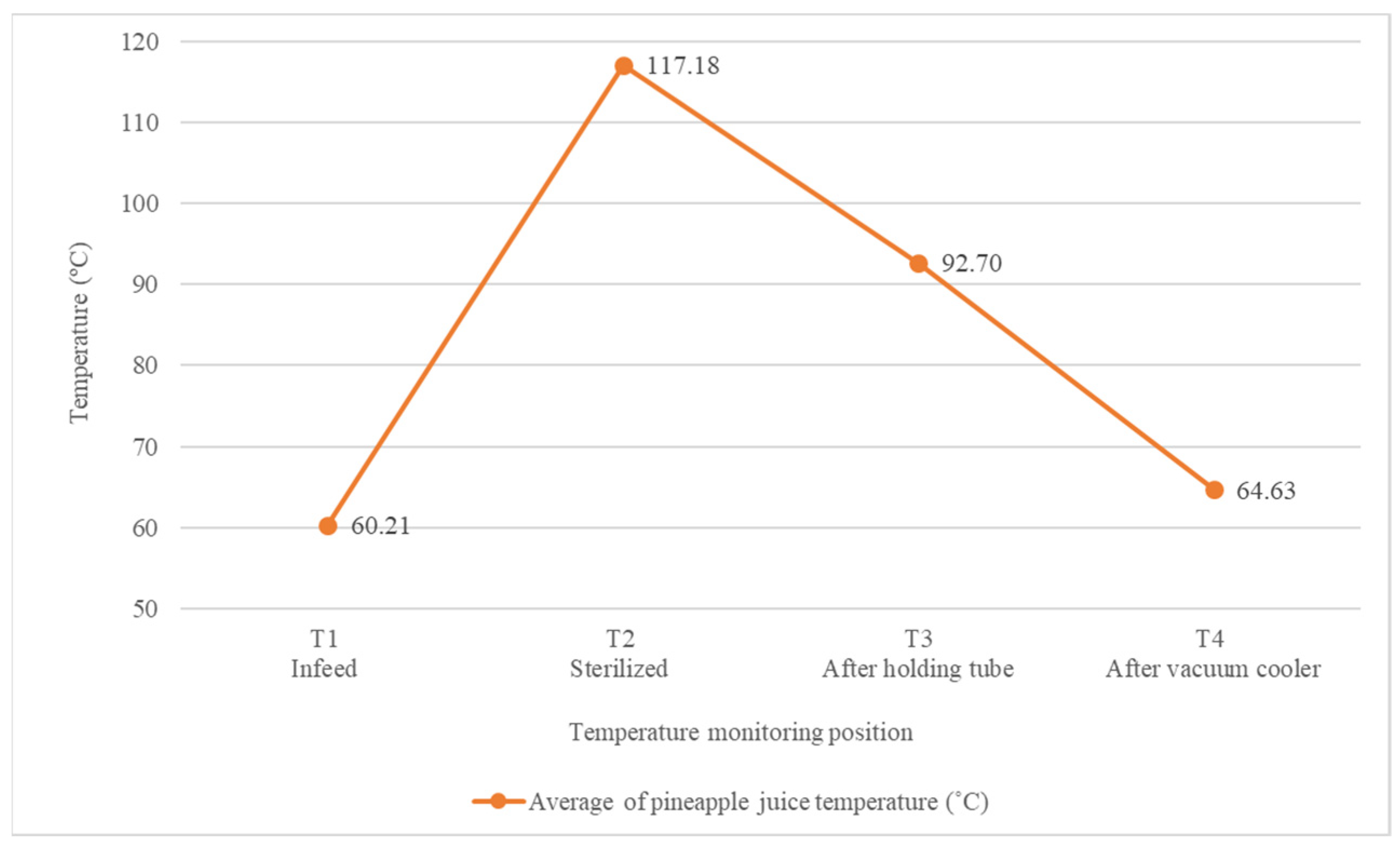Design and Development of Innovative Steam Injection for High-Temperature Short-Time Liquid Foods
Abstract
1. Introduction
2. Materials and Methods
2.1. Design of Continuous Thermal Sterilizer Using Impingement Steam Jet
2.2. Water Test
2.3. Pineapple Juice Test
2.4. Statistical Analysis
3. Results and Discussion
3.1. Effect of Jet Nozzle Number and Steam Temperatures of 120 °C, 125 °C or 130 °C
3.2. Effect of Dimensionless Jet-to-Target Distance
3.3. Pineapple Juice Test
4. Conclusions
Author Contributions
Funding
Institutional Review Board Statement
Informed Consent Statement
Data Availability Statement
Acknowledgments
Conflicts of Interest
References
- Doran, P.M. Bioprocess Engineering Principles, 2nd ed.; Elsevier: Amsterdam, The Netherlands, 2013; pp. 761–852. ISBN 978-0-12-220851-5. [Google Scholar]
- Jelen, P. Experience with Direct and Indirect UHT Processing of Milk—A Canadian Viewpoint. J. Food Prot. 1982, 45, 878–883. [Google Scholar] [CrossRef] [PubMed]
- Lewis, M.; Heppell, N. Continuous Thermal Processing of Foods Pasteurization and UHT Sterilization; Aspen Publishers, Inc.: Gaithersburg, MD, USA, 2000; pp. 57–103. ISBN 0-8342-1259-5. [Google Scholar]
- Mota, F.A.S.; Carvalho, E.P.; Ravagnani, M.A.S.S. Modeling and Design of Plate Heat Exchanger. In Heat Transfer Studies and Applications; Kazi, S.N., Ed.; IntechOpen: London, UK, 2015; pp. 165–199. [Google Scholar] [CrossRef]
- Emond, S. Continuous Heat Processing. In Thermal Technologies in Food Processing; Richardson, P., Ed.; Woodhead Publishing Limited: Cambridge, UK, 2001; pp. 29–48. ISBN 1-85573-558-X. [Google Scholar]
- Xu, Q.; Liu, W.; Li, W.; Yao, T.; Chu, X.; Guo, L. Experimental investigation on interfacial behavior and its associated pressure oscillation in steam jet condensation in subcooled water flow. Int. J. Heat Mass Transf. 2019, 145, 118779. [Google Scholar] [CrossRef]
- Geers, L.F.G. Multiple Impinging Jet Arrays: An Experimental Study on Flow and Heat Transfer. Ph.D. Thesis, Technical University Delft, Delft, The Netherlands, 9 February 2004. [Google Scholar]
- Penumadu, P.S.; Rao, A.G. Numerical Investigations of Heat Transfer and Pressure Drop Characteristics in Multiple Jet Impingement System. Appl. Therm. Eng. 2016, 110, 1511–1524. [Google Scholar] [CrossRef]
- Tsaoulidis, D.; Angeli, P. Liquid-liquid Dispersions in Intensified Impinging-jets Cells. Chem. Eng. Sci. 2017, 171, 149–159. [Google Scholar] [CrossRef]
- Specht, E. Impinging Jet Drying. In Modern Drying Technology, 1st ed.; Tsotsas, E., Mujumdar, A.S., Eds.; Wiley-VCH GmbH: Weinheim, Germany, 2014; pp. 1–25. ISBN 978-3-527-31560-4. [Google Scholar]
- Wen, X.; Li, Z.; Zhou, W.; Liu, Y. Interaction of Dual Sweeping Impinging Jets at Different Reynolds Numbers. Phys. Fluids 2018, 30, 105105. [Google Scholar] [CrossRef]
- Lawal, D.U.; Abubakar, A.A.; Alharbi, M.B.; Ben-Mansour, R. A Numerical Study of Steady and Unsteady Flow and Heat Transfer from a Confined Slot Jet Impinging on a Constant Heat Flux Wall. J. Mech. Eng. Technol. 2014, 6, 1–17. [Google Scholar]
- Zuckerman, N.; Lior, N. Jet Impingement Heat Transfer: Physics, Correlations, and Numerical Modeling. Adv. Heat Transf. 2006, 39, 565–574. [Google Scholar]
- Shakouchi, T.; Kito, M.; Tsuda, M.; Tsujimoto, K.; Ando, T. Flow and Heat Transfer of Impinging Jet from Notched-Orifice Nozzle. J. Fluid Sci. Technol. 2011, 6, 453–464. [Google Scholar] [CrossRef][Green Version]
- Ostermann, R.A. Direct Steam Injection Heating of Liquid Food Products. Master’s Thesis, Oklahoma State University, Stillwater, OK, USA, December 2005. [Google Scholar]
- Patil, P.M.; Yadav, A.P.; Patil, P.A. Comparative Study between Heat Transfer through Laminar Flow and Turbulent Flow. Int. J. Innov. Res. Sci. Eng. Technol. 2015, 4, 2223–2226. [Google Scholar]
- Ekkad, S.V.; Gao, L.; Hebert, R.T. Effect of Jet-to-Jet Spacing in Impingement Arrays on Heat Transfer. In Proceedings of the IMECE2002 ASME International Mechanical Engineering Congress & Exposition, New Orleans, LA, USA, 17–22 November 2002. [Google Scholar]
- Glynn, C.; O’Donovan, T.; Murray, D.B. Jet Impingement Cooling. In Proceedings of the 9th UK National Heat Transfer Conference, Manchester, UK, 5–6 September 2005. [Google Scholar]
- Mistry, E.; Prajapati, J.P.; Suneeta, V.P. Innovative Steam Injection for Milk Processing. In Proceedings of the 11th Indian Dairy Industry—Opportunities and Challenges. SMC College of Dairy Science, Anand Agricultural University, Anand, GJ, India, 8–9 January 2015. [Google Scholar]
- Xu, Q.; Liu, W.; Li, W.; Yao, T.; Chu, X.; Guo, L. Numerical investigation on thermal hydraulic characteristics of steam jet condensation in subcooled water flow in pipes. Int. J. Heat Mass Transf. 2022, 184, 122277. [Google Scholar] [CrossRef]
- Yamane, Y.; Ichikawa, Y.; Yamamoto, M.; Honami, S. Effect of Injection Parameters on Jet Array Impingement Heat Transfer. Int. J. Gas Turbine Propuls. Power Syst. 2012, 4, 27–34. [Google Scholar] [CrossRef]
- Lytle, D.; Webb, B.W. Air Jet Impingement Heat Transfer at Low Nozzle-Plate Spacings. Int. J. Heat Mass Transf. 1994, 37, 1687–1697. [Google Scholar] [CrossRef]
- Petruzzi, L.; Campaniello, D.; Speranza, B.; Corbo, M.R.; Sinigaglia, M.; Bevilacqua, A. Thermal Treatments for Fruit and Vegetable Juices and Beverages: A Literature Overview. Compr. Rev. Food Sci. Food Saf. 2017, 16, 668–691. [Google Scholar] [CrossRef] [PubMed]
- Singh, R.P.; Heldman, D.R. Introduction to Food Engineering, 2nd ed.; Academic Press, Inc.: Cambridge, MA, USA, 1993; pp. 95–112. ISBN 0-12-646381-6. [Google Scholar]
- Berhanu, M.; Adal, M.; Sahile, S. Microbial Quality Spectrum of Packed and Fresh Fruit Juices in Gondar Town Supermarkets and Cafes, Northwestern Ethiopia. J. Microbiol. Res. 2020, 10, 45–54. [Google Scholar]
- Hounhouigan, M.H.; Linnemann, A.R.; Soumanou, M.M.; Boeke, M.A.J.S.V. Effect of Processing on the Quality of Pineapple Juice. Food Rev. Int. 2014, 30, 112–133. [Google Scholar] [CrossRef]
- Moore, K.L.; Dake, T.W.; McBride, J.E. Juice Sterilization Process. EP0247245A1, 2 December 1987. [Google Scholar]
- Leneveu, J.C.; Quentin, B.; Assemat, S.; Remize, F. Maintaining Physicochemical, Microbiological, and Sensory Quality of Pineapple Juice (Ananas comosus, Var. ‘Queen Victoria’) through Mild Heat Treatment. Processes 2020, 8, 1186. [Google Scholar] [CrossRef]
- Molana, M.; Banooni, S. Investigation of Heat Transfer Processes Involved Liquid Impingement Jets: A Review. Braz. J. Chem. Eng. 2013, 30, 413–435. [Google Scholar] [CrossRef]
- O’Donovan, T.S. Fluid Flow and Heat Transfer of an Impinging Air Jet. Ph.D. Thesis, University of Dublin, Dublin, Ireland, March 2005. [Google Scholar]
- Notification of Ministry of Public Health (No. 356) 2013. Re: Beverages in Sealed Container. Available online: http://food.fda.moph.go.th/law/data/announ_moph/V.English/P356_E.pdf (accessed on 7 December 2021).
- Hounhouigan, M.H.; Linnemann, A.R.; Soumanou, M.M.; Van Boekel, M.A.J.S. Effect of Heat Treatment on Yeast Inactivation, Vitamin C and Physicochemical Quality of Fresh Pineapple Juice. Afr. J. Food Sci. 2020, 14, 256–264. [Google Scholar]
- Lagnika, C.; Adjovi, Y.C.; Lagnika, L.; Gogohounga, F.O.; Do-Sacramento, O.; Koulony, R.K.; Sanni, A. Effect of Combining Ultrasound and Mild Heat Treatment on Physicochemical, Nutritional Quality and Microbiological Properties of Pineapple Juice. Food Sci. Nutr. 2017, 8, 227–241. [Google Scholar] [CrossRef]
- Tobolková, B.; Durec, J.; Belajová, E.; Mihalíková, M.; Polovka, M.; Suhaj, M.; Daško, L.; Šimko, P. Effect of Light Conditions on Physico-Chemical Properties of Pineapple Juice with Addition of Small Pineapple Pieces During Storage. J. Food Nutr. Res. 2013, 52, 181–190. [Google Scholar]






| Injection Plates | Water/Steam Temperature | Jet Nozzle Diameter | Jet Nozzle Number | Flow Rate (kg/h) | Reynolds Number |
|---|---|---|---|---|---|
| Water | 60 °C | 2 mm | 2 | 50.00 | 9476 |
| 3 | 50.00 | 6317 | |||
| 4 | 50.00 | 4738 | |||
| Steam | 120 °C | 1 mm | 6 | 10.23 | 46,543 |
| 9 | 11.29 | 34,228 | |||
| 20 | 13.27 | 18,098 | |||
| Steam | 125 °C | 1 mm | 6 | 12.42 | 55,721 |
| 9 | 14.41 | 43,123 | |||
| 20 | 15.55 | 20,932 | |||
| Steam | 130 °C | 1 mm | 6 | 16.22 | 71,865 |
| 9 | 17.94 | 52,984 | |||
| 20 | 19.57 | 26,009 |
| Impingement Condition | Steam Temperature = 120 °C | Steam Temperature = 125 °C | Steam Temperature = 130 °C | ||||
|---|---|---|---|---|---|---|---|
| Product Nozzle | Steam Nozzle | Sterilized Temperature (°C) | % Heat Transfer Efficiency | Sterilized Temperature (°C) | % Heat Transfer Efficiency | Sterilized Temperature (°C) | % Heat Transfer Efficiency |
| 2 | 6 | 111.82 ± 0.10 e | 76.08 ± 0.15 e | 116.52 ± 0.12 d | 71.29 ± 0.34 d | 121.29 ± 0.25 d | 64.01 ± 1.04 d |
| 2 | 9 | 110.76 ± 0.18 c | 71.99 ± 0.28 c | 116.87 ± 0.14 e | 65.13 ± 0.10 b | 122.79 ± 0.12 e | 60.90 ± 1.44 c |
| 2 | 20 | 112.16 ± 0.13 f | 64.30 ± 0.34 a | 118.68 ± 0.50 f | 64.12 ± 1.15 ab | 124.13 ± 0.07 fg | 58.87 ± 0.44 a |
| 3 | 6 | 107.91 ± 0.29 a | 72.76 ± 0.24 c | 113.57 ± 0.15 a | 68.95 ± 0.17 c | 119.63 ± 0.04 a | 62.83 ± 0.32 d |
| 3 | 9 | 110.57 ± 0.15 c | 72.24 ± 0.28 c | 116.15 ± 0.11 c | 65.17 ± 0.66 b | 120.75 ± 0.07 c | 59.92 ± 0.03 abc |
| 3 | 20 | 112.20 ± 0.15 f | 64.93 ± 0.95 a | 119.17 ± 0.17 g | 63.65 ± 0.47 a | 124.28 ± 0.02 h | 59.12 ± 0.48 ab |
| 4 | 6 | 110.19 ± 0.17 b | 74.52 ± 0.51 d | 115.53 ± 0.09 b | 71.57 ± 0.11 d | 120.41 ± 0.07 b | 62.72 ± 0.39 d |
| 4 | 9 | 111.17 ± 0.04 d | 70.27 ± 0.15 b | 116.24 ± 0.05 c | 64.33 ± 0.56 ab | 121.41 ± 0.07 d | 60.41 ± 0.35 bc |
| 4 | 20 | 112.82 ± 0.18 g | 64.81 ± 0.54 a | 118.80 ± 0.17 f | 63.69 ± 0.76 a | 124.05 ± 0.11 f | 59.28 ± 0.89 ab |
| Impingement Condition | Steam Temperature = 120 °C | |||
|---|---|---|---|---|
| Product Nozzles | Steam Nozzles | H/d | Sterilization Temperature (°C) | % Heat Transfer Efficiency |
| 2 | 6 | 1 | 115.97 ± 0.37 c | 78.45 ± 0.21 c |
| 3 | 111.93 ± 0.13 b | 75.63 ± 0.82 b | ||
| 5 | 111.82 ± 0.10 b | 76.08 ± 0.20 b | ||
| 7 | 109.11 ± 0.22 a | 73.72 ± 0.64 a | ||
| Diluted Pineapple Juice Treatment | Color | pH | TSS (°Brix) | Total Plate Count (CFU/mL) | ||
|---|---|---|---|---|---|---|
| L* | a* | b* | ||||
| Untreated at ambient temperature | 33.15 ± 0.57 a | −0.50 ± 0.23 a | 14.30 ± 0.82 a | 4.48 ± 0.47 a | 12.0 ± 0.00 b | 1.8 × 104–3.0 × 105 |
| Pretreated at 60 °C | 33.36 ± 0.76 a | −0.48 ± 0.16 a | 14.10 ± 0.37 a | 4.20 ± 0.03 a | 12.0 ± 0.00 b | 42–340 |
| After passing holding tube | na | na | na | na | na | <1.0 |
| After passing vacuum cooler | 32.24 ± 0.28 a | −0.27 ± 0.30 a | 14.58 ± 0.35 a | 4.20 ± 0.02 a | 11.87± 0.07 a | na |
Publisher’s Note: MDPI stays neutral with regard to jurisdictional claims in published maps and institutional affiliations. |
© 2022 by the authors. Licensee MDPI, Basel, Switzerland. This article is an open access article distributed under the terms and conditions of the Creative Commons Attribution (CC BY) license (https://creativecommons.org/licenses/by/4.0/).
Share and Cite
Sangsom, W.; Inprasit, C. Design and Development of Innovative Steam Injection for High-Temperature Short-Time Liquid Foods. Processes 2022, 10, 161. https://doi.org/10.3390/pr10010161
Sangsom W, Inprasit C. Design and Development of Innovative Steam Injection for High-Temperature Short-Time Liquid Foods. Processes. 2022; 10(1):161. https://doi.org/10.3390/pr10010161
Chicago/Turabian StyleSangsom, Wilasinee, and Chouw Inprasit. 2022. "Design and Development of Innovative Steam Injection for High-Temperature Short-Time Liquid Foods" Processes 10, no. 1: 161. https://doi.org/10.3390/pr10010161
APA StyleSangsom, W., & Inprasit, C. (2022). Design and Development of Innovative Steam Injection for High-Temperature Short-Time Liquid Foods. Processes, 10(1), 161. https://doi.org/10.3390/pr10010161





